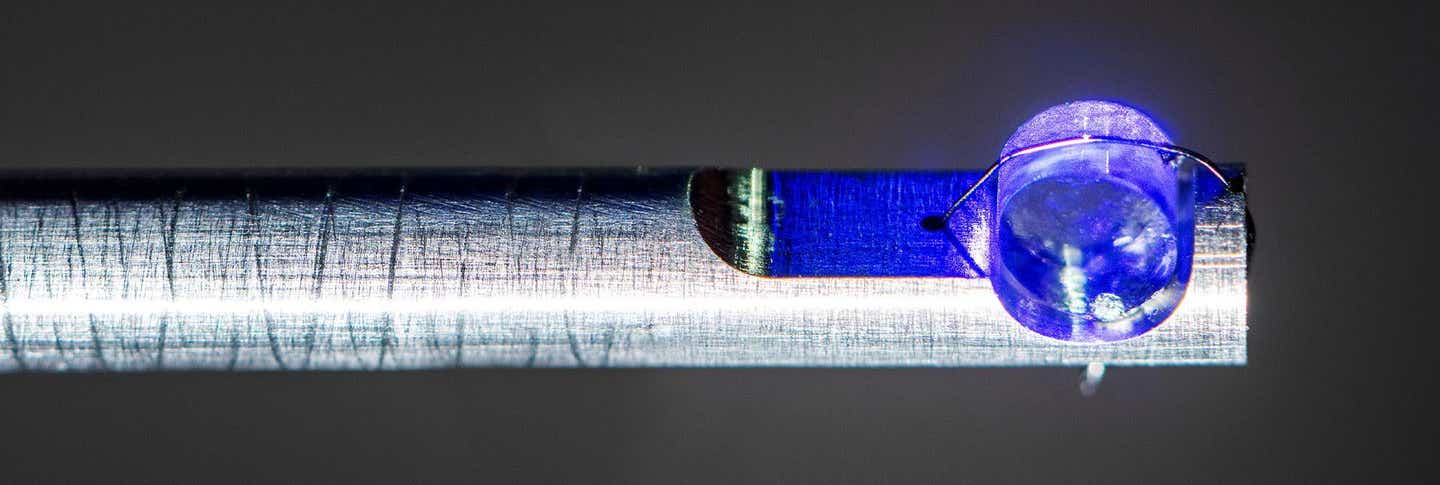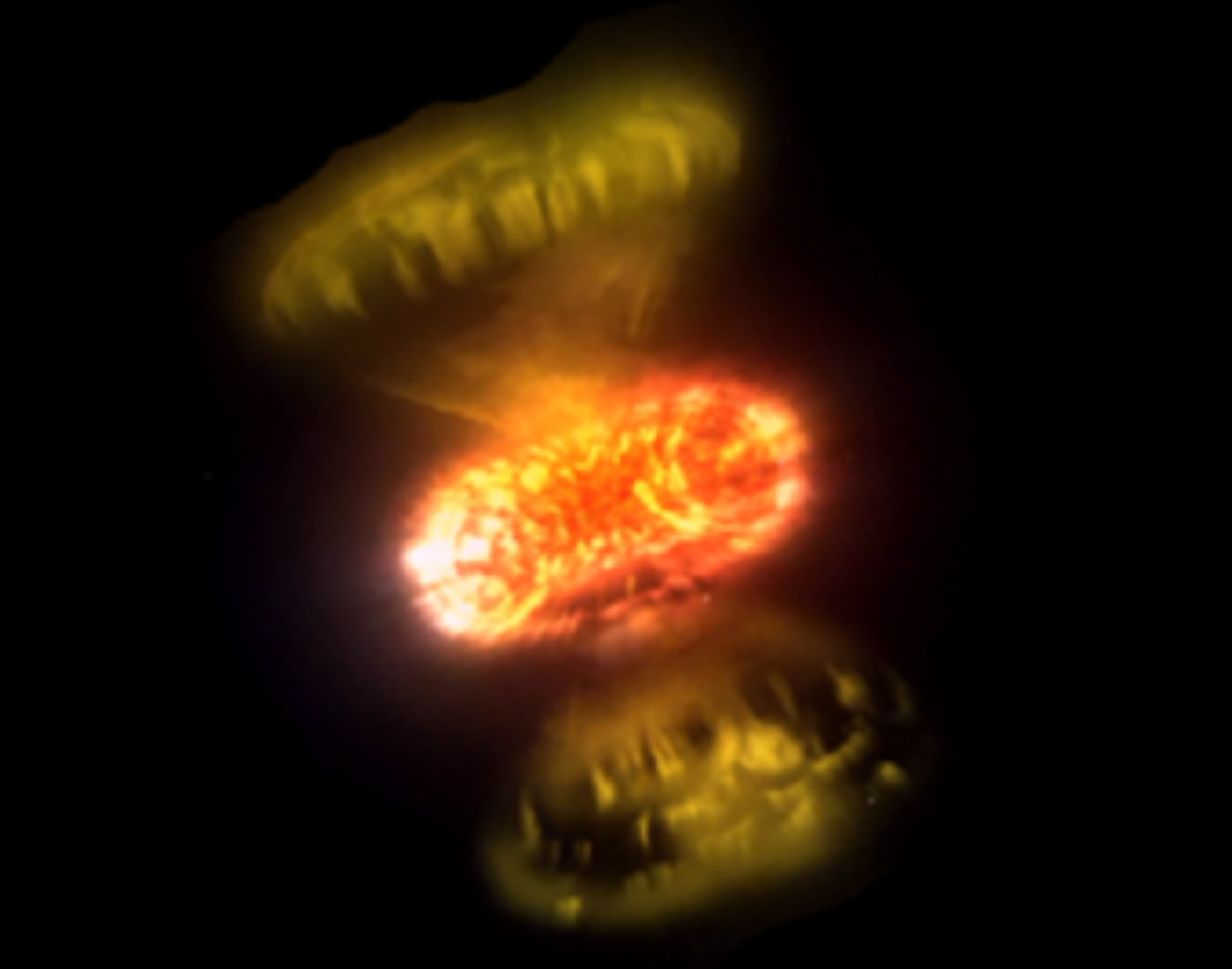Laser-excited thorium-229 pioneers major breakthrough in dark matter detection
Thorium-229’s unique nuclear traits offer billion-fold sensitivity to detect ultralight dark matter before nuclear clocks exist.

Scientists have used laser-excited thorium-229 nuclei to pioneer a new method for detecting dark matter, offering up to a billion times more sensitivity than existing techniques. (CREDIT: Weizmann Wonder Wander)
Key Takeaways
- Scientists have used laser-excited thorium-229 to probe for ultralight dark matter, even without a fully built nuclear clock.
- Thorium-229’s unique nuclear transition offers up to a billion times more sensitivity to fundamental forces than current methods.
- This new technique opens a fresh path for dark matter searches, potentially detecting effects 100 million times weaker than gravity.
For nearly a century, scientists have tried to solve one of the greatest mysteries in physics: the nature of dark matter. While it makes up most of the universe’s mass, dark matter remains invisible and barely interacts with the matter you know.
But thanks to recent advances in laser technology and nuclear physics, researchers have taken a major step toward detecting it—by using thorium-229, a rare isotope with a nuclear quirk that could reveal the hidden structure of the cosmos.
A Unique Nuclear Transition Becomes a Scientific Opportunity
Most nuclear transitions require intense gamma rays to excite an atom’s core. Thorium-229, however, is different. Its nucleus can be nudged into a higher energy state using ultraviolet laser light—far gentler than gamma radiation. This rare trait makes thorium-229 ideal for building a nuclear clock, a timekeeping device so precise it could detect forces 10 trillion times weaker than gravity.
While such a clock hasn’t yet been built, researchers from the Weizmann Institute of Science, led by Prof. Gilad Perez and postdoctoral fellow Dr. Wolfram Ratzinger, saw an immediate opportunity. By analyzing how thorium-229 responds to laser light, they found a way to test whether dark matter is subtly influencing nuclear behavior—even without a full-fledged nuclear clock.
They published their findings in Physical Review X, showing how changes in thorium’s nuclear absorption spectrum might reveal interactions with ultralight dark matter, a leading candidate in modern dark matter theories.
A New Method for Detecting the Undetectable
Ultralight dark matter models suggest the universe could be filled with incredibly light particles that act like a background wave. These particles may slightly change how atomic nuclei behave, including the energy they absorb or emit. By scanning thorium-229’s nuclear resonance frequency—essentially how much energy it takes to excite its nucleus—scientists can look for tiny, regular oscillations that would signal the presence of these particles.
Related Stories
- First-ever thorium nuclear optical clock - the world’s most accurate timekeeper
- New optical atomic clock is 1,000x more accurate than today's standard
- Microscopic magnet powers search for dark matter in the universe
Ratzinger and his team analyzed the first fluorescence spectrum ever captured from laser-excited thorium-229 nuclei. They didn’t detect any telltale oscillations, but their analysis allowed them to place new limits on how strongly dark matter could be interacting with ordinary matter—across a wide range of particle masses, from 10⁻²⁰ to 10⁻¹³ electronvolts.
Their results may be less strict than existing limits from atomic clocks and other tools, but thorium-229 offers something those methods can’t: extreme sensitivity to nuclear-level changes. In fact, the team believes thorium-229 could provide up to a billion times greater sensitivity than current atomic standards.
Resonance Frequency: A Key to Hidden Forces
In a traditional atomic clock, electrons jump between energy levels, and the frequency of those jumps defines time. But electrons are easily influenced by outside interference like electric fields.
A nuclear clock, by contrast, would rely on a nucleus’s transition, which is far more stable and isolated. That’s why researchers are so excited about thorium-229, whose low-energy nuclear transition makes it possible to measure shifts with laser light.
To find a nucleus’s resonance frequency, scientists expose it to a range of laser frequencies. When the energy input matches the nucleus’s natural oscillation, it absorbs more light—like a child swinging higher when pushed at just the right moment. This creates a peak in an absorption spectrum. Any deviation in that peak’s location or shape could mean that external forces, like dark matter, are at play.
Earlier studies struggled to pinpoint thorium-229’s resonance frequency with high accuracy. But that changed last year. A team from the National Metrology Institute of Germany (PTB) first recorded relatively precise data. Shortly after, scientists at the University of Colorado improved the measurement by a factor of a million.
Perez’s team took this data and showed that it could already be used to probe for dark matter. Their analysis found that even tiny frequency shifts could expose interactions between dark matter particles and the quarks and gluons inside atomic nuclei.
Future Clocks and Quantum Tools
If a full nuclear clock is built in the coming years, it could revolutionize timekeeping and boost research in quantum physics, navigation, communications, and more. Unlike atomic clocks, which can drift due to electrical noise, nuclear clocks would offer unmatched stability. This would allow researchers to detect the faintest forces in nature—opening new frontiers in both technology and fundamental science.
The potential doesn’t stop there. Because thorium-229’s nuclear transition is so sensitive to variations in the strong nuclear force, it could also be used to test other theories in particle physics. These include ideas involving axions, dilatons, and other hypothetical bosons that might form dark matter.
Using a VUV (vacuum ultraviolet) laser system, researchers at PTB were able to excite thorium-229 ions embedded in crystals such as CaF₂ and LiSrAlF₆. These advances allowed them to reduce uncertainty in the transition energy by three orders of magnitude. Future improvements using VUV frequency combs could narrow the spectral linewidth down to just hundreds of hertz, greatly increasing precision.
In Ratzinger’s analysis, the main limitation so far has been the width of the laser itself, not the nucleus. As lasers improve, scientists expect to measure with much finer detail—reaching levels where even minuscule effects from dark matter could leave a signature.
A Billion-Times Leap in Sensitivity
Most traditional dark matter detection methods rely on atomic transitions, hyperfine structure, or mechanical oscillators. But these are not very sensitive to nuclear-scale changes. Optical atomic clocks offer better precision, but their nuclear contributions are small—often only parts per million.
By contrast, thorium-229’s nuclear transition can respond directly to changes in the strong nuclear force, where most ultralight dark matter models predict interactions. According to the researchers, this gives thorium-229 an estimated advantage of 100 million to 1 billion in sensitivity over current devices.
Even though a nuclear clock isn’t ready yet, the data gathered from laser-excited thorium-229 nuclei already opens new ways to test physics beyond the Standard Model. The same method could also apply to other systems, such as the x-ray laser excitation of the scandium-45 isomer or future experiments with trapped thorium ions.
This pioneering work shows how pushing forward in one scientific field—like laser spectroscopy—can unlock doors in another, such as dark matter research. The fact that this new method doesn't even need a fully developed nuclear clock makes it a powerful tool for early exploration of deep cosmic questions.
As Ratzinger puts it, “This is a region where no one has yet looked for dark matter.” Now, thanks to thorium-229, that’s beginning to change.
Note: The article above provided above by The Brighter Side of News.
Like these kind of feel good stories? Get The Brighter Side of News' newsletter.



